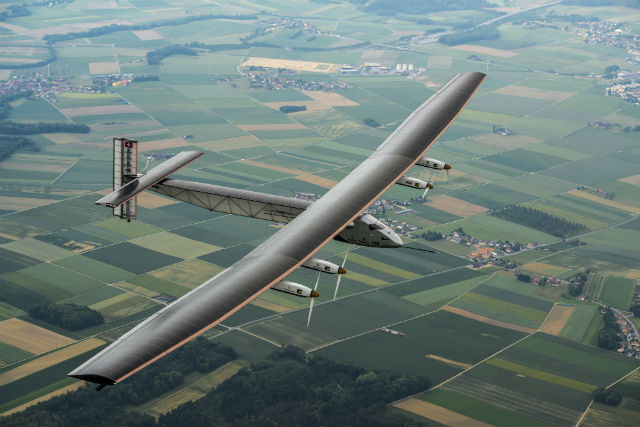Five years after their ambitious solar powered flight project first got airborne, Bertrand Piccard and André Borschberg have entered final preparations for the first leg of a five-month, 12-stage journey around the world from Abu Dhabi.
Weather permitting, Monday 9 March’s flight will be a 400km jump to Muscat, Oman, with an estimated flying time of 12h and consuming no fuel, only the electric power harvested by the solar panels on its wing surfaces. But subsequent legs will be far more gruelling, ultimately including a two-step crossing of the Pacific Ocean, from Nanjing, China via Hawaii – a distance which will require the solo pilot and delicate aircraft to endure a stretch of five or six days aloft.
The aircraft, Solar Impulse 2, recently completed a 12h test flight around Abu Dhabi. Critical to the plan is the ability to fly through the night on power harvested during daylight, a capability demonstrated by its smaller predecessor, Solar Impulse 1.
Also critical to the success of the project are exotic materials and construction techniques. Solar Impulse 2 has a wingspan of 72m (a Boeing 747-8I comes in at 68.5m), but weighs just 2,300kg – about the mass of a car and including its 2,077kg load of lithium batteries.
For pilots and programme founders Piccard and Borschberg, the multiple-leg itinerary is about more than keeping the effort inside their physiological limits, though. As they stress, the project is not really about aviation – it is about energy efficiency. That is, they hope that doing something very, very difficult illustrates that great things can be achieved, today, with existing technology. Stopping along the way and talking to people about it is, ultimately, the point.
In any case, the Payerne, Switzerland-based project is led by a pair of seasoned aviators well-suited to the task. Piccard is a medical doctor whose aviation pedigree includes the 1985 European acrobatic hang-gliding title and captaining the 1999 Breitling Orbiter non-stop round-the-world balloon flight. Borschberg is a mechanical engineer, formerSwissair force pilot, consultant and entrepreneur.
As Borschberg told Flightglobal during the Solar Impulse 1 campaign, the project is really a bid to show the world that it can solve its formidable environmental challenges with technologies that are available today. Indeed, he said at that time, only two of Solar Impulse's technology partners were in aviation:Dassaultand Germany's DLR research agency. The others are about meeting the project's energy efficiency demands.
At that time, in 2012, Bernd Rothe of Bayer MaterialScience, one of the project's key partners, told Flightglobal that it is best not to think about Solar Impulse as an aircraft project. Rather, he said, this is a renewable energy project and, at least from Bayer's perspective: "It's mainly about weight."
However, when it comes to weight, aircraft designers may ultimately owe much to Solar Impulse. Rothe liked to point out that the project's pioneering use of a carbon nanotube-reinforced epoxy resin is dramatically improving the mechanical properties of the carbonfibre-reinforced plastic that makes up much of the aircraft's structure.
Some of that CFRP is in “paper thin” sheets.

Solar Impulse 2 in testing over Switzerland
Solar Impulse
Source: FlightGlobal.com























